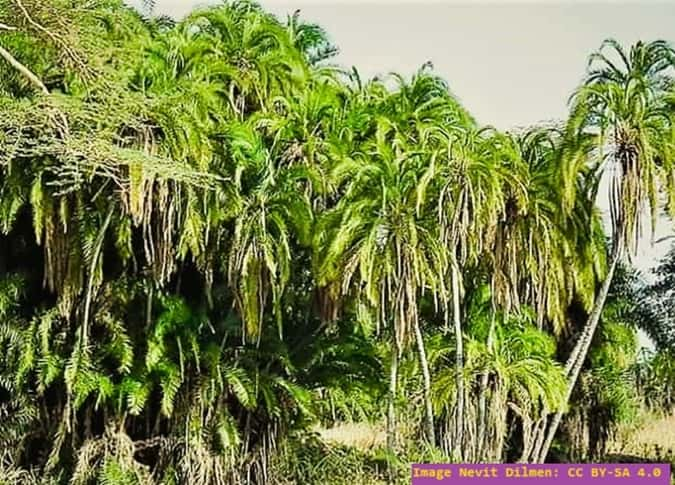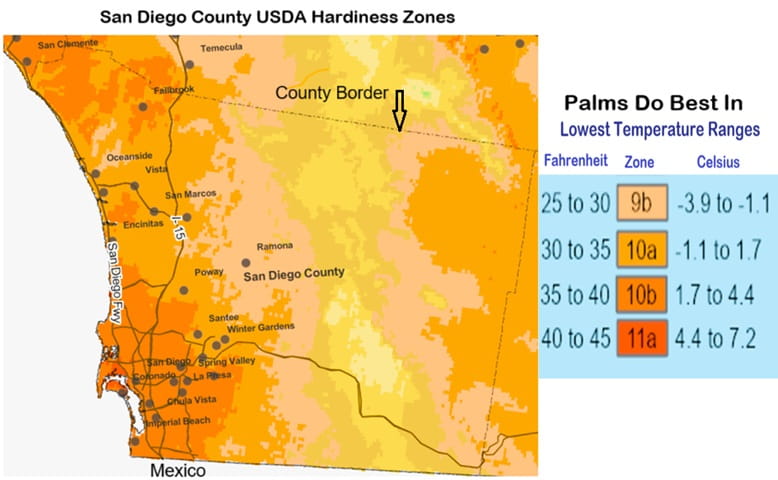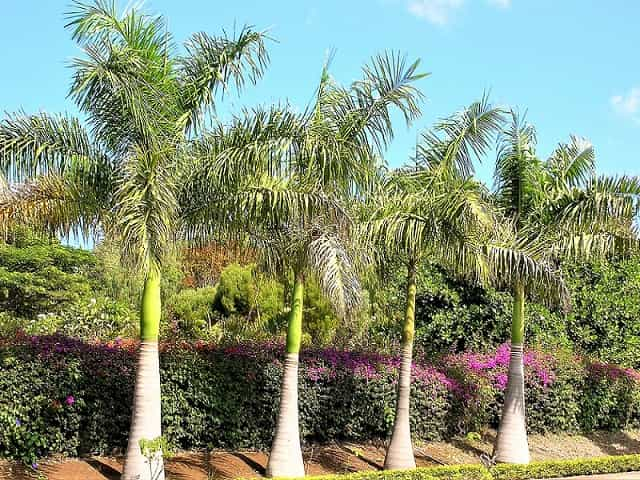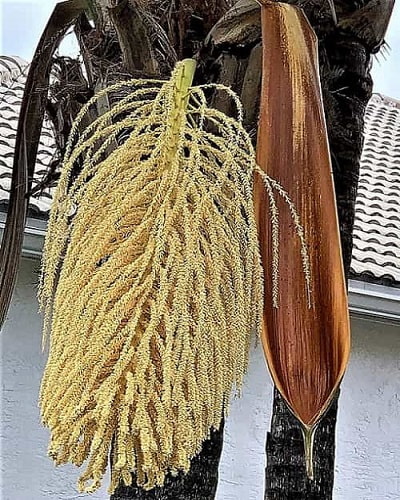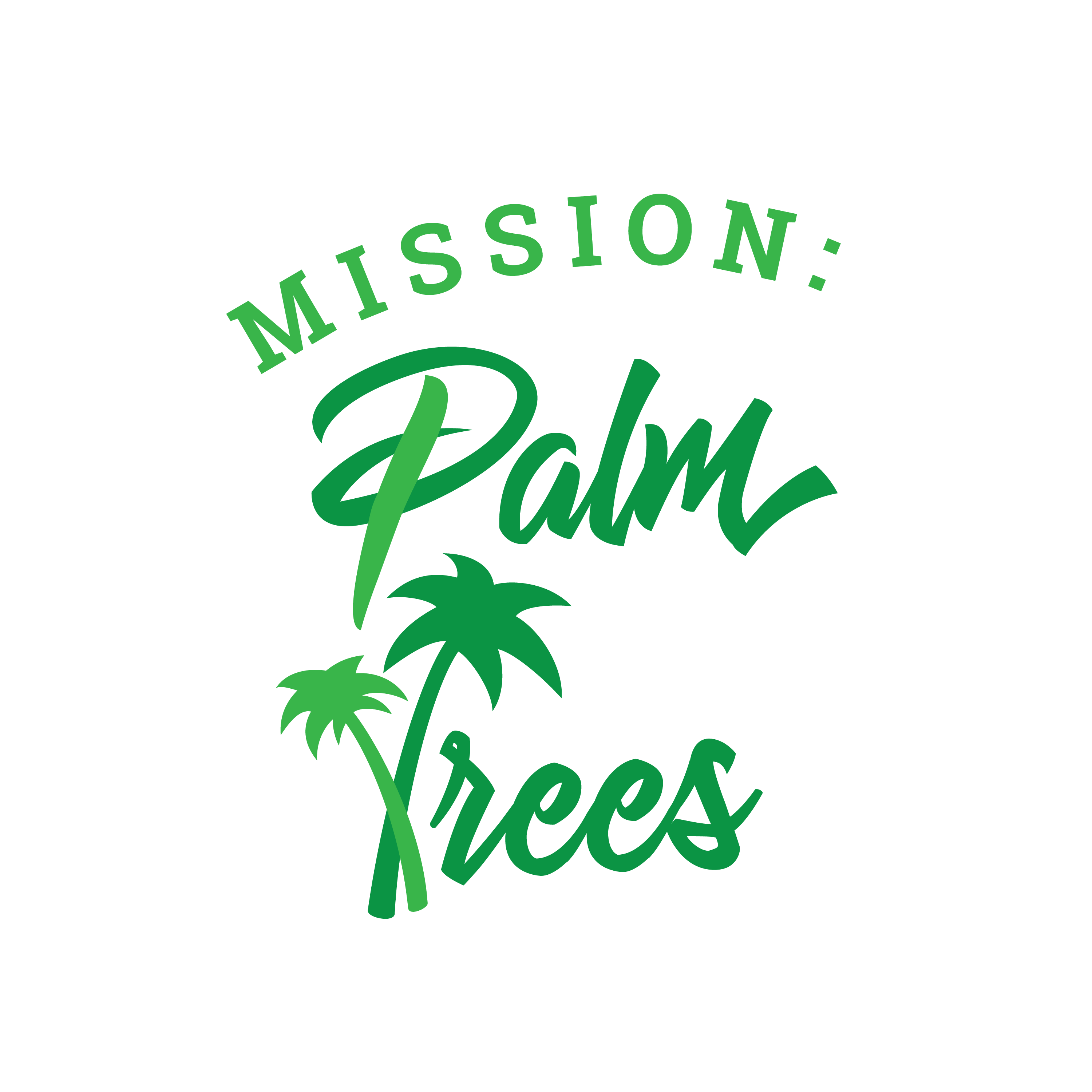- Home
- Where Palms Grow
- Where are Palms Native?
Where Are Palm Trees Native?
Have you traveled, seeing palms so many places? Maybe unexpected areas? You looked up in wonder, thinking: where are palm trees native?
The palm family has five sub-families. Evidence shows where palm trees were & are native. Original species from up to 80 million years ago!
Palm trees grow many places where you'd think. Tropical & sub-tropical climates, to areas outside of the tropics. But that doesn't mean they're native to all of those areas.
How can we know where a palm tree originated?
At Mission: Palm Trees
Palm lovers can soothe their palm-related searches and concerns. Our articles are intended to inform, while having fun, easily Finding What You Want or Need. Without unneeded shoptalk & tiring endless research. We Research For You!
Where Do Palm Trees Come From?
3 Reasons Why Temperature Affects Palm Growth
TEMPERATURE is the true dividing point.
How sensitive a palm is to low temperatures made a difference for where palm trees originally came from. Figured by the lowest temperatures in an area during typical years.
WHY TEMPERATURE? It's because of Palm Tree Structures:
- Innards made of watery soft plant flesh
- That squishy tissue can't tolerate frost
- Palms never developed dormant states
All these conditions relate to where are palm trees native. Their beginnings were mainly in tropical & subtropical areas.
There are Exceptions That You Should Know
A few Hardy Palm Species are limited exceptions. They developed in warmer parts of temperate climates.
Think of the lowest temps reached during the coldest times of the year. If they're regularly & consistently above 32oF/0oC, some species adapted to survive where palm trees are now native. As long as the lower range was short-lived.
ELEVATION COUNTS!
Elevation can change tropical-like areas to temperate, or even near-alpine. With increased altitude. In many areas, the higher you go, the cooler the temps.
So where are palm trees native, growing naturally? And in which parts of the world?
This is How the Palm Tree Story Began
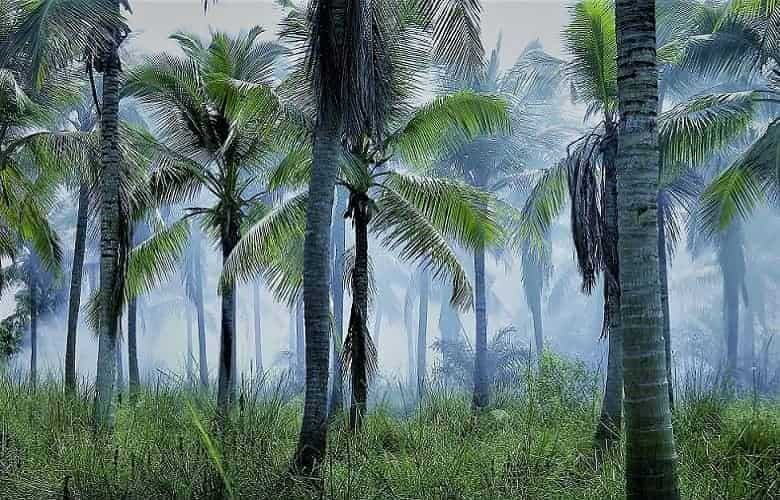 Palm Tree Groves like these don't exist just anywhere!
Palm Tree Groves like these don't exist just anywhere!Have you seen a palm forest like this?
FOSSIL FINDS
Palm trees left fossil examples. Archeological scientists are confident palms are some of the oldest plants around. Studying fossil evidence, they figured out where native palm trees are originally from.
During the beginnings of the Eocene Epoch, tropical-like humid climates were abundant throughout the earth. That's where palm trees became native. Developing, in so many places.
Many areas now don't support where palms are native. Even no longer existing.
WHEN PALM TREES GREW IN ALASKA!
For example, the Eocene Epoch is the time-frame when palm trees grew in Alaska.
Toward the Eocene's end, ice ages put the earth in a deep-freeze!
More changes in climate over time affected where palm trees natively developed & grew. Eliminating palms from Alaska, and similar climates.
With all of that, then, which areas of our planet earth supported where palm trees are native. In more recent eras, where do palm trees originally come from? Let's see...
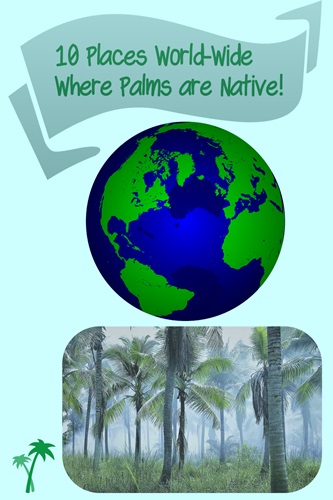
NEW ZEALAND - One Native Palm
Palms originating IN ASIA
SOUTH AMERICA has Native Palm Trees
Also, here are Endemic Palms in NORTH AMERICA
Lots of natives in THE CARIBBEAN
EUROPE has an Endemic Palm
Where are Palms Native IN AFRICA?
AUSTRALIAN Indigenous Palms
Are Palm Trees Native IN MEXCO?
ISLAND NATIVES of the South Pacific & Indian Ocean
Where Are Palm Trees Native
In Unexpected Places?
Why New Zealand Has a Native Palm Tree
The Nīkau palm is the only palm tree that originally sprung up in New Zealand.
Its species name is Rhopalostylis sapida. Nīkau is a Maori word describing palm tree leaves.
Most of the country is temperate with warm summers, according to Köppen climate types. Temperatures in winter months, through most areas don't get below freezing.
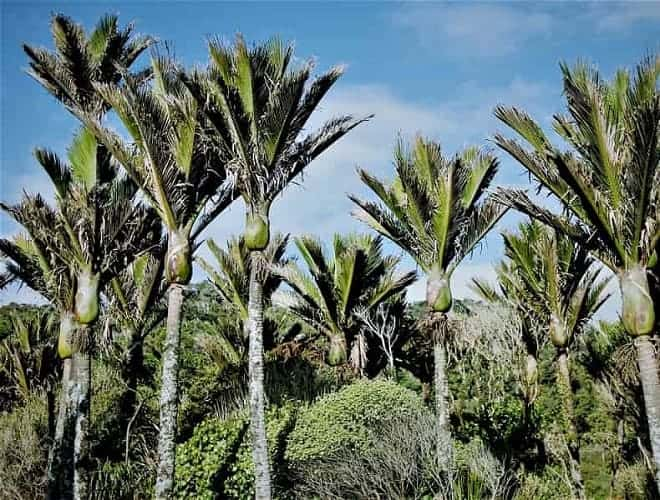 The Nīkau Palm: Found on North, South & offshore islands of New Zealand
The Nīkau Palm: Found on North, South & offshore islands of New ZealandMountainous areas get snowfall.
High peaks have snow all or most of the year. You won't see the native New Zealand palm there!
Some say New Zealand has a subtropical climate in upper areas of North Island. You'll know that's not accurate, going by climate science.
How was the Nīkau palm able to natively develop in New Zealand? In lower elevations, their average temperatures are consistently above freezing.
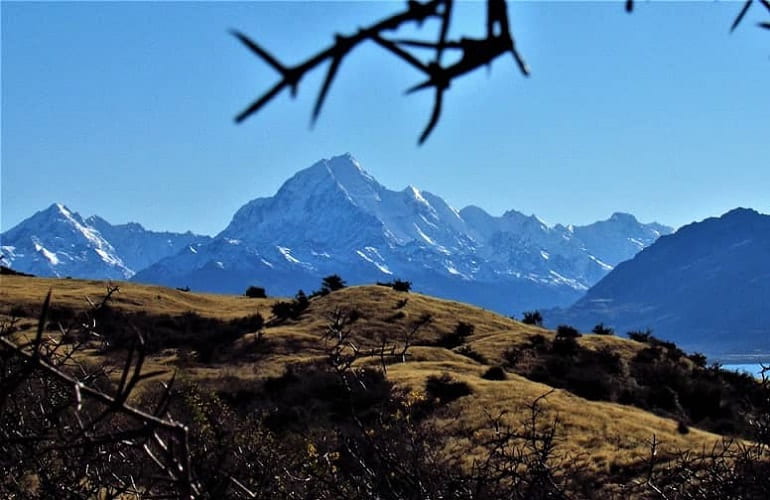 Late May (autumn) View of Mt. Cook in New Zealand
Late May (autumn) View of Mt. Cook in New ZealandSouth Island - NZ's Highest Peak - No Palms Here!
Look at the Native Palm Tree of Europe
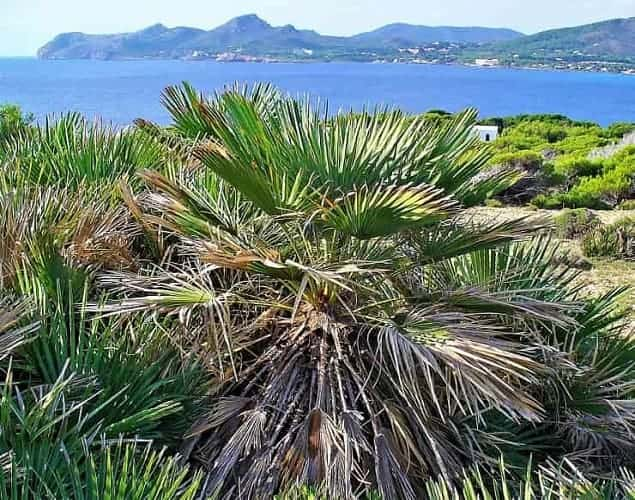 Naturally growing Mediterranean Fan Palms at Punta de Capdepera in Majorca, Spain. Photo: H. Zell - CC BY-SA 4.0
Naturally growing Mediterranean Fan Palms at Punta de Capdepera in Majorca, Spain. Photo: H. Zell - CC BY-SA 4.0The Mediterranean Fan Palm's species name is Chamaerops humilis.
People also call it the European Fan Palm or Mediterranean Dwarf Palm. When the thermometer dips into freezing temps, it can take it. For a little while.
It likes poor-type rubbly soil. Preferably in hilly areas.
Imagine being the above pic's photographer! Try to get in all the clumping plants. It spreads like that by growing offshoots. Some plants have multiple trunks.
WHERE IT'S NATIVE
Originating in milder European & northwestern Africa areas.
It arose along Mediterranean coasts of Spain, Italy, Portugal, France and on islands. And developed around the Atlas Mountains of Algeria, Morocco, and Tunisia.
Here are the Palms Trees Native to Africa
This huge continent has many climates.
All supporting places where palm trees are native. From hot sand dunes to steamy forest jungles & warm plains.
SOME NATIVE AFRICAN PALMS
These palms are indigenous to various areas of Africa.
- Borassus Palm - Also called African Fan Palm or Selati Palm or by species name Borassus aethiopum. Look up, as it may get to 72 feet!
- Lala Palm - Species: Hyphaene coriacea. Full grown, a petite sort, to about 29 feet.
- Locals delightedly find it quite useful.
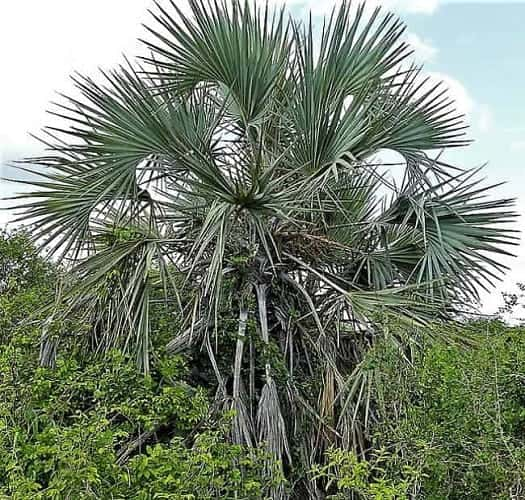 Lala Palm Tree. Photo: Bernard Dupont - CC BY-SA 4.0
Lala Palm Tree. Photo: Bernard Dupont - CC BY-SA 4.0- Northern Lala Palm - Hyphaene petersiana, also called Real Fan Palm or Vegetable Ivory Palm. May grow to 59 feet.
- Prefers higher water table turf, like swampy regions and near rivers. Very much a tropics lover.
- Pondo Coconut Palm Tree - Species: Jubaeopsis caffra. Known as Dwarf Pondoland Palm or Mkambati Palm. Only maxing out about 16 feet. Has fruit like small coconuts.
- Wild Date Palm - The Phoenix reclinata averages 20 feet. Not straight-up like many dates! It's got multiple upward, curving trunks. Maybe why it's named "wild" - hmmm!
GENUS RAPHIA
26 species are endemic somewhere in Africa. Many have huge palm fronds. Some famed are:
- Kosi Palm - Raphia australis is endemic to KwaZulu-Natal and Mozambique. For construction usages, people just love it.
- Raffia Palm - Raphia ruffia has origins in stream-side areas of Zimbabwe where it feels at home. Also with enormous leaves, and can reach 59 feet.
- Raphia farinifera - Prefers swampy or riverside areas in many African countries. Reaches about 65 feet high.
- West African Piassava Palm - Raphia vinifera is also called Bamboo Palm and West African Bass Fibre Palm. What's unique is its oil has "mind-numbing" effects on fish.
 Raphia vinifera
Raphia viniferaPhoto: Forest & Kim Starr - CC BY 4.0
- Bismarck Palm - Bismarckia nobilis is easy-going, sun-loving, & 60ft/18m tall. With massive waxy bluish-green palm fronds are massive.
- Hurricane Palm - Dictyosperma album gets to 30 feet tall. Nice looking. Nicknamed because of resistant reputation to storm winds. But hot drying winds really irritate it! Even burning the leaves.
Palm Trees Endemic to Asia
Another huge continent.
Many historically originated in approximately the southern half. Where it's long been suited for palm tree growth.
NOTABLE ASIAN PALMS
- Borassus Palm - (Borassus flabellifer) is Cambodia's National Tree, where it's called "Tnaot" in the Khmer language.
- Several common names: Doub Palm, Palmyra Palm, Tal or Tala Palm, Toddy Palm, Wine Palm (several species also use this name!) or Ice Apple.
- Impressive! Look up - almost 100 ft. tall!
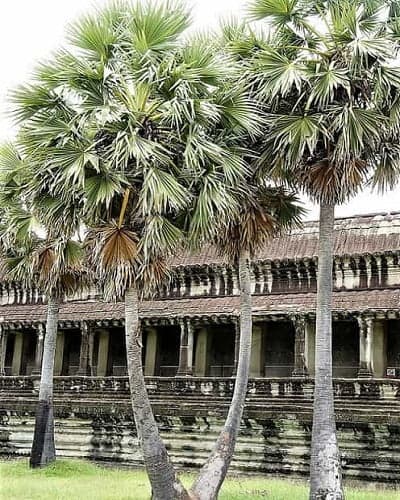 Borassus flabellifer, called Tnaot in Khmer.
Borassus flabellifer, called Tnaot in Khmer.Photo in Angkor Wat by Michael Hermann
CC BY-SA 4.0
- Satake Palm - Named for Toshihiko Satake: Satakentia liukiuensis. This Japanese business owner noted this palm's uniqueness. He brought it loving attention.
- Also called Satakentia Palm, Yaeyama Palm, Yaeyama-yashi, and in Japanese: ヤエヤマヤシ.
- Native to southernmost Japan's Ryukyu Islands.
DATE PALMS
Known for the fruits, most species are variably edible. Some only for animal feed! Asian Date Palm species:
- Dwarf Date Palm - Native in the Himalayas - surprisingly! Phoenix acaulis, means trunkless. Another name: Stemless Date Palm.
- As you may imagine, it's quite small.
- Likes elevations to almost 5000 feet in Northern India, Bhutan and Nepal, where it's indigenous.
- Andaman Island Date Palm - Phoenix andamanensis (Binomial: S.Barrow added to distingush it from a similar one). Somewhat newly discovered in the Andamans, in the Bay of Bengal.
- Mountain Date Palm - Phoenix loureiroi, also called Vuyavuy Palm and Voyavoy Palm. Native through varied terrain of Southern Asia to 4900 feet.
- Two varieties: Loureiroi & pedunculata.
- Mangrove Date Palm - Phoenix paludosa. Get the hint of its growing preference? Swampy!
- Also called Sea Dates. Native in coastal areas of Southeast Asia.
- Ceylon Date Palm - Phoenix pusilla is small. Also called Flour Palm. Native in southern India and Sri Lanka.
- Robellini Palm - Phoenix roebelenii, aka Pygmy Date Palm and Miniature Date Palm. Original in Southern China to Northern Southeast Asia.
- Attractive, but thorny (watch it!).
- Did you think it was smaller sized? You're right!
- Cliff Date Palm - Phoenix rupicola is endemic to mountainous/hilly cliffs of India & Bhutan. Somewhat endangered, on the "Near-Threatened" List.
- Silver Date Palm - Phoenix sylvestris, native to mid southern Asia. Also called Indian Date, Sugar Date Palm or Wild Date Palm.
- Try fermenting its sap for a hot toddy. It's what locals do!
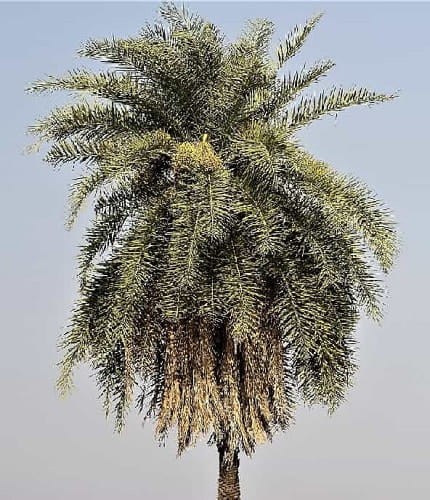 Ready for a wild date & a hot toddy?
Ready for a wild date & a hot toddy?Photo: Andhra P Jeganathan - CC BY-SA 4.0
Native Palm Trees of Australia
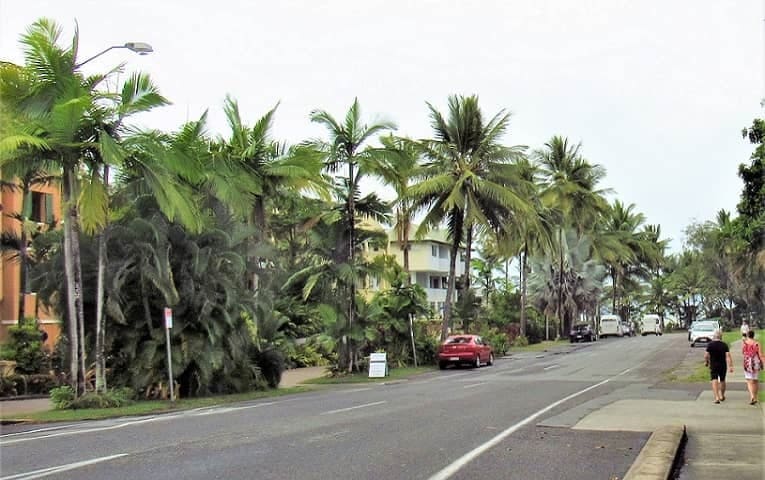 Walking along Palm Lined Macrossan St. to 4-Mile Beach in Port Douglas, Australia
Walking along Palm Lined Macrossan St. to 4-Mile Beach in Port Douglas, AustraliaUnique animal & plant species in these large country. We've traveled Australia for months. We love seeing all the palms here.
Nearly the entire place is suitable for growing some type of palm. We wondered while there, if any we saw were indigenous. Went to the Darwin Botanical Garden trying to figure that out. A gorgeous place. Highly recommend it!
NATIVE AUSSIE PALMS
We found a bunch endemic to various Australian climes, particularly tropics & subtropics.
LIVISTONIA
This genus loves warm coastal areas. Numerous species are native to all states/territories except Tasmania. Most are tropical types, but some are "deserty."
THE ENVIRONMENTS LOVED
Dry Sorts - Even though they'd smile with added water, they do well in the dry.
- Livistonia humilus - Smallest palm of the genus, origins in Northern Territory (NT) eucalyptus bushland plains.
- Doesn't mind lacking water for a time. But do you hear that "ahhhh" from its fronds with the summer wet?!
- Central Australian Cabbage Palm - Livistonia mariae, an NT native. Plus over eastern & western borders into Queensland & Western Australia (WA).
- Millstream Palm - Livistonia alfredii comes from far northwestern NT, near the Indian Ocean.
- Liking lots of sun & heat, but can do some cold!
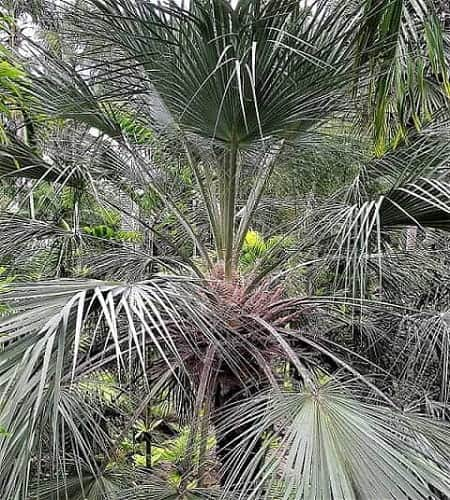 Livistonia alfredii or Millstream Palm
Livistonia alfredii or Millstream PalmPhoto: Scott-Zona - CC BY 4.0
Swampy Palms - Could be in hills or lowlands. But likes mushy grounds.
- Australian Fan Palm - Livistonia australis, locally called: Fan Palm. Some call it Australian Cabbage Palm.
- Grows in upland or forested boggy areas.
Rain Foresty - Loving the rain, especially many Queensland & NT rainforest areas.
- Livistonia benthamii does love flatland rain forests. But not too fussy, it's found near swamps & rivers, too.
- It's got a "knobby" look to its trunk. But still looks pretty!
By the Riverside - These species like it near flowing waters.
- Livistonia lorophylla prefers river valleys. Naturally grew in the Kimberly. It's okay with drought & some cold, too.
- Livistonia fulva likes tablelands in Queensland. Look for it near springs. The kind that make streams through gullies & into gorges.
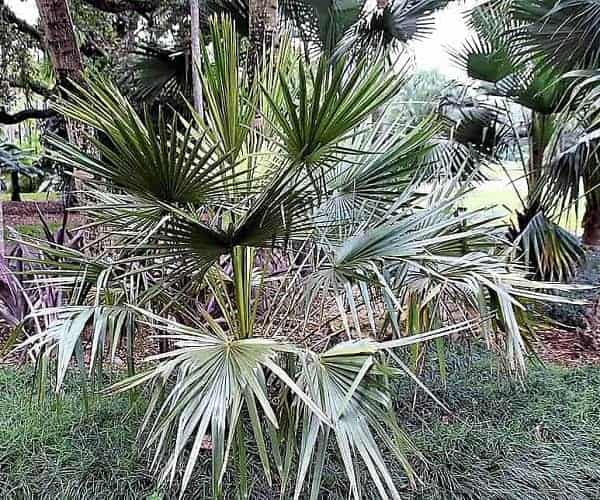 The Livistona fulva native to Queensland Australia
The Livistona fulva native to Queensland AustraliaPhoto: David J Stang - CC BY-SA 4.0
Our Latest Update
-
San Diego palm trees: History, Species, and Their SoCal Charm
Fascinated by San Diego palm trees? Discover their history, types, and why they're a staple of SoCal’s SD neighborhood scenery to inspire your landscape design.
MORE PALM TREES NATIVE TO AUSTRALIA
KENTIA PALM - AKA Sentry Palm. Howea forsteriana, named for politician & land squatter, William Forster.
- Arose natively on low coastal areas of Lord Howe Island off the central Pacific coast.
- It likes regular precipitation & can survive momentary frost.
PICCABEAN PALM - Also called Bangalow Palm. Archontophoenix cunninghamiana grows natively, but infrequently, on Australia's central east coast.
- It prefers drier Mediterranean climates.
ALEXANDER PALM - Known also as Solitaire Palm. Ptychosperma elegans is native to eastern Queensland coastal rainforests. It loves rainy weather & warmth.
- Wonder if it "wants to be alone...?"
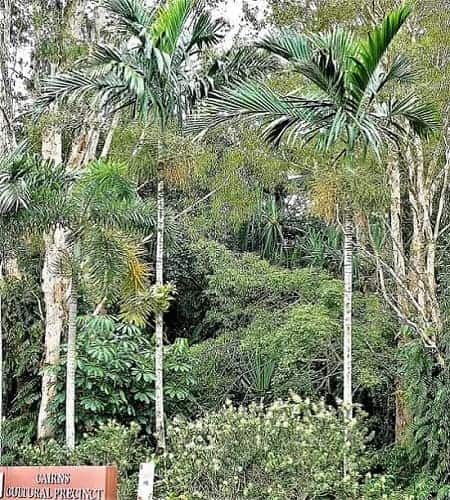 Ptychosperma elegans in Cairns Botanic Gardens - Photo: Steve Fitzgerald - CC BY-SA 4.0
Ptychosperma elegans in Cairns Botanic Gardens - Photo: Steve Fitzgerald - CC BY-SA 4.0Where Palm Trees Are Native in South America
Much of South America has endemic palm trees. Some of interest:
SEASHORE PALM:
Allagoptera arenaria, clustering palm native to Brazil. Per its name it does like the shore. Originating on coastal dunes, it's adapted to salty ground & air spray.
COSTA RICAN BAMBOO PALM:
The Chamaedorea costaricana, as you thought, originated in Central American. In Costa Rica. It's shrubby, with no main trunk.
PACAYA:
Chamaedorea tepejilote. Origins from Central America extending south to Columbia. Its multiple trunks look similar to bamboo stalks.
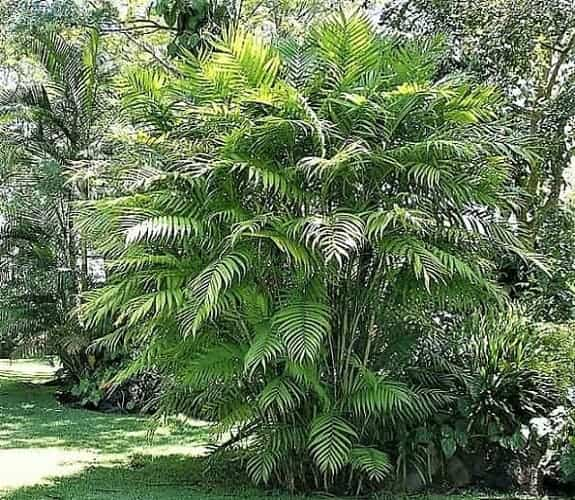 Pacaya Palm in Atitlan Guatemala.
Pacaya Palm in Atitlan Guatemala.Photo: Hermann Luyken - CC BY-SA 4.0
CARNAUBA WAX PALM:
Copernicia prunifera has waxy fronds, used commercially. Native to Brazil, it's easily adaptable.
- The trunk's twisty swirling leaf base scars give it a delightful unique look.
QUEEN PALM:
Syagrus romanzoffiana, also called Cocos Plumosa. Endemic from southern Brazil south to Argentina, it's pretty resilient. Reaching about 40 feet up.
JELLY PALM:
AKA Pindo Palm. Butia capitata's indigenous roots are around central inland areas of Argentina, Uruguay, & southern Brazil.
- Per its nickname, the fruit makes a yummy jelly. Ever tried some?
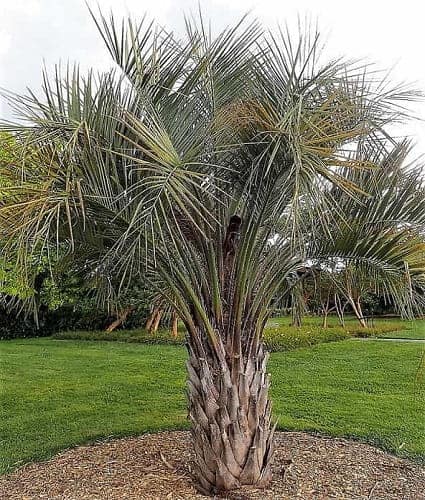 Pindo or Jelly Palm - Where's the Fruit?
Pindo or Jelly Palm - Where's the Fruit?It's Coming - For Your Favorite Jelly Recipe!
Photo: Krzyszt Ziarnek - CC BY-SA 4.0
PARLOR PALM:
Native to Central America, this Chamaedorea elegans is also called Neanthe Bella.
- Small palm, often a potted indoor specimen (you may have guessed!). But caution, as it can irritate skin.
CHILEAN WINE PALM:
Jubaea chilensis, native to Chile. The palm had fearful chills at one time. Was used for sugar & alcohol (hence its wine name).
- Traditionally when harvested, it was cut down. Becoming endangered, it's now protected in Chile.
- Doesn't like weather extremes.
- Some are living happily in a Queensland Park, as you can see here:
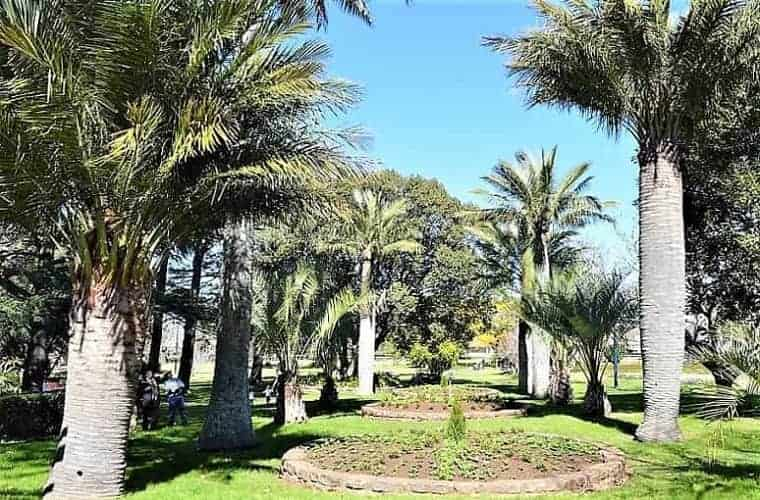 Chilean Wine Palms at Laurel Bank Park in Toowoomba Queensland
Chilean Wine Palms at Laurel Bank Park in Toowoomba QueenslandPhoto: Heritage Branch Staff - CC BY 4.0
Endemic Palms of North America
USA NATIVE PALM TREES
In the United States, southernmost and southeastern states have native palms.
That's North & South Carolina, Georgia, Florida, Alabama, Mississippi, Louisiana, Texas, Arkansas, Oklahoma, California, Arizona & New Mexico. All have at least one indigenous species.
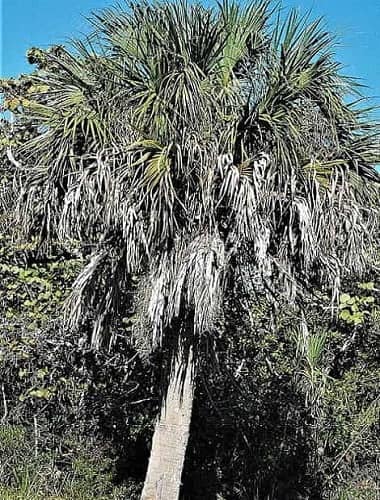 Cabbage Palm - Sabal Palmetto
Cabbage Palm - Sabal PalmettoState tree of South Carolina & Florida
Photo: James St John - CC BY 4.0
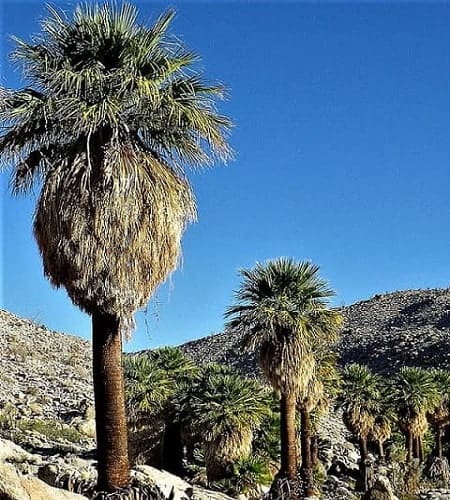 Desert Fan, California Fan or Petticoat Palm
Desert Fan, California Fan or Petticoat PalmWashingtonia filifera - California & Arizona Native. Photo: Florian - CC BY-SA 4.0
FLORIDA
The only state with true tropical areas, has multiple types.
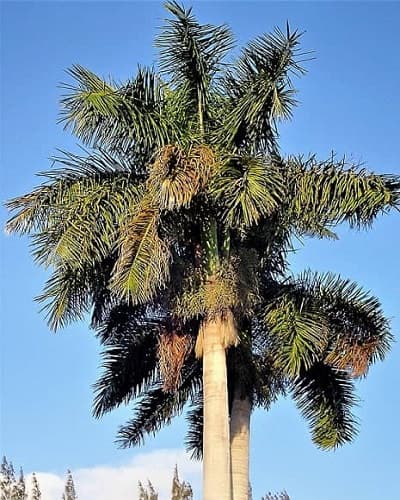 Florida Royal Palm, Roystonea regia
Florida Royal Palm, Roystonea regiaPhoto: James St John - CC BY 4.0
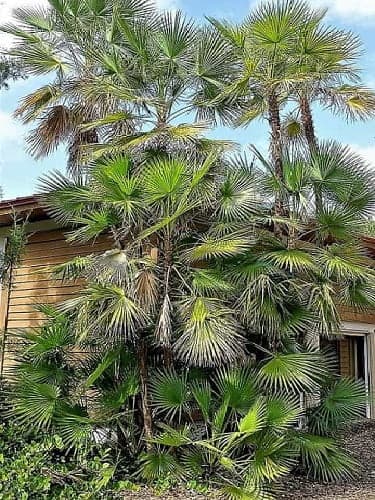 Everglades Palm: Acoelorrhaphe wrightii
Everglades Palm: Acoelorrhaphe wrightiiAt Mounts Botanical Gardens in FL
HAWAII
Hawaiian native palms are there, for sure. Did you figure that?
- 24 species of the Pritchardia genus are located amidst 8 different Hawaiian Islands.
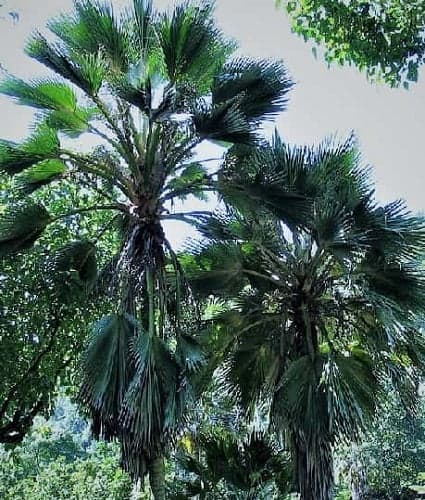 Blue Loulu Palm Tree | Pritchardia hillebrandi
Blue Loulu Palm Tree | Pritchardia hillebrandiNative to Molokai'i
Photo: David Eickhoff - CC BY 4.0
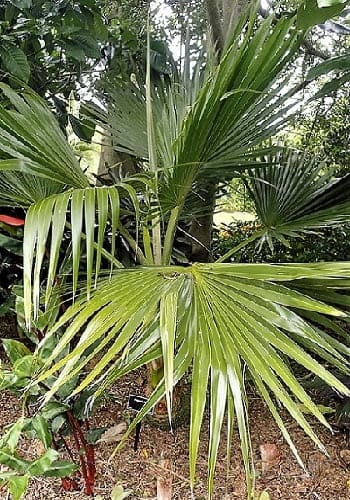 Kona Fan Palm - Pritchardia affinis
Kona Fan Palm - Pritchardia affinisNative to the Big Island
Photo: Krzyszt Ziarnek - CC BY-SA 4.0
COUNTRY OF MEXICO
Diverse native palm trees grow in climates from deserts to rain forests.
Some species are Gaussia maya (Maya Palm) & Brahea edulis (Guadalupe Palm).
MORE PALM TREES NATIVE TO MEXICO
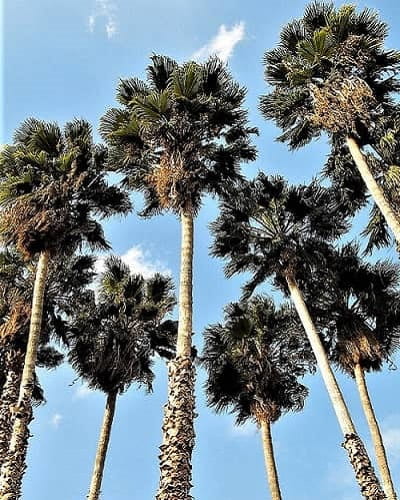 Washingtonia robusta | Native Mexican!
Washingtonia robusta | Native Mexican!Called Mexican Fan Palm
Photo: enuser Geographer - CC BY-SA 4.0
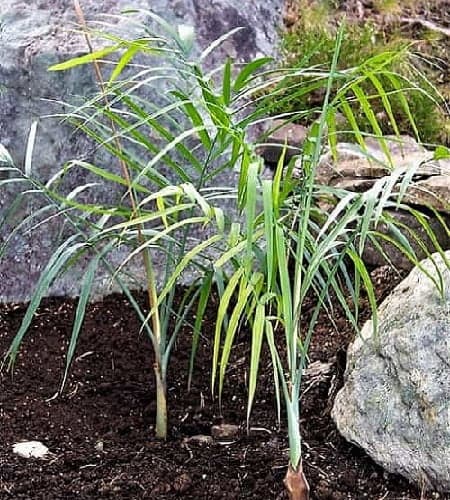 Chamaedorea radicalis | Radicalis Palm
Chamaedorea radicalis | Radicalis PalmIndigenous to Mexico.
Photo: Danerik K - CC BY 4.0
Throughout the Caribbean Islands palm trees are also endemic. Palm tree species native in the Caribbean are:
- Thrinax morrisii (aka Key Thatch Palm & Peaberry Palm) on limestone/sandy coastal Caribbean beaches
- Pseudophoenix sargentii (Buccaneer Palm) at varied Caribbean seashore climes. It's easily adaptable.
- Coccothrinax argentata (Silver Palm) from the Bahamas. Reflective silvery underside leaves remind you of its strength, adapting to what comes its way!
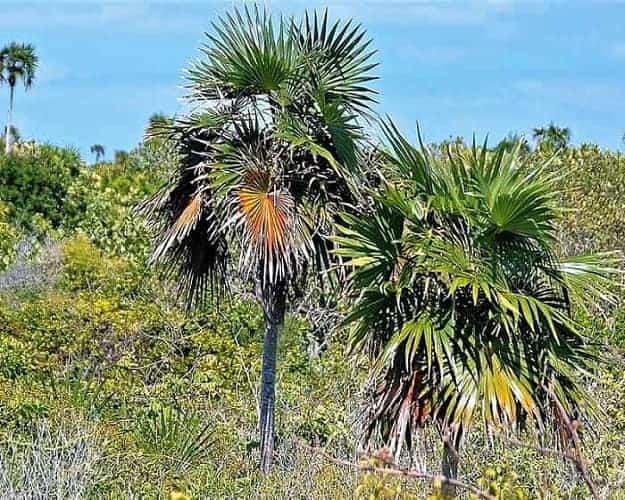 Coccothrinax argentata - Called Silver Thatch Palm
Coccothrinax argentata - Called Silver Thatch PalmOn San Salvador Island - Native in the Bahamas
Photo: James St John - CC BY 4.0
- Acrocomia aculeata (Macaw Palm) indigenous to Dominica & Martinique. Prefers rocky, unobstructed, dryer areas.
- Sabal causiarum (Hat Palm) originating in Puerto Rico. What could it be used for? Hmmm!
- Roystonea regia (Cuban Royal Palm) - Bet you can guess where this palm originated!
South Pacific & Indian Ocean Island Palms
During the Ice Age the South Pacific & Indian Ocean Island areas experienced maximum temperatures of 32oF (0oC) to -76oF (-60oC). After the ice ages these areas warmed enough to develop indigenous palms. Here are some:
- Winin Palm - Veitchia winin is native to Vanuatu in the South Pacific. (Watch Survivor? You'll remember this island group.) Pretty adaptable & easy going for many palmy areas.
- Dwarf Sugar Palm - Arenga tremula is native to the Phillippines. This shrubby low palm is happily adaptable.
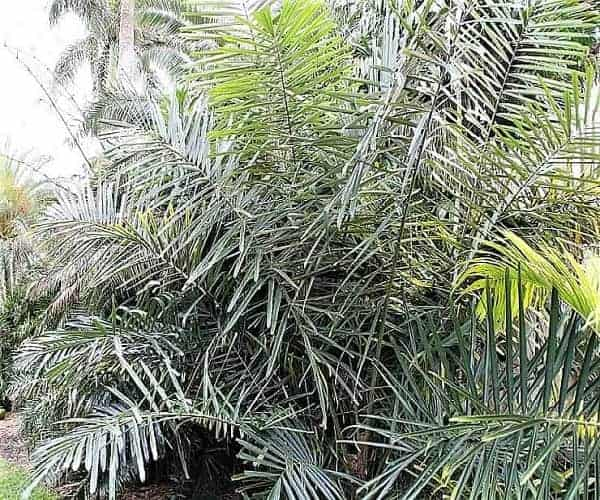 Arenga tremula is commonly known as the Dwarf Sugar Palm.
Arenga tremula is commonly known as the Dwarf Sugar Palm.Photo: David J Stang - CC BY-SA 4.0
- Ivory Cane Palm - Pinanga kuhlii is native to Java and Sumatra. Out of the rain forest comes this nice looking palm.
- Lucubensis Palm - Chrysalidocarpus lucubensis is now called Dypsis lucubensi. It's endemic to Nossi-Bé Island (means Big Island, aka Nosy Be), off northwestern Madagascar. A handsome tree!
- Triangle Palm - Neodypsis decaryi was changed to Dypsis decaryi. It originated in Madagascar. The nickname surely describes its triangular canopy!
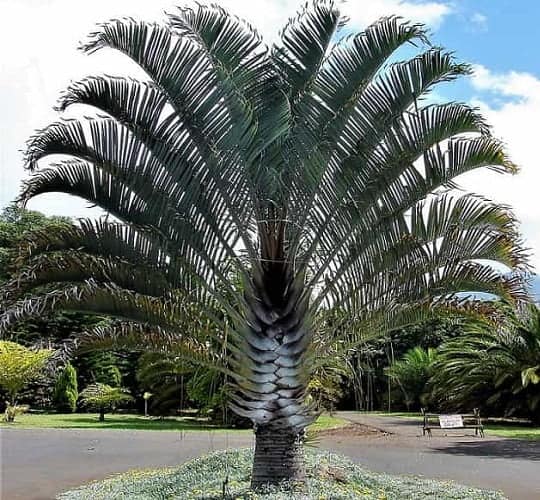 Do You Think "Triangle Palm" is an Appropriate Name?
Do You Think "Triangle Palm" is an Appropriate Name?Definitely Has its Own Unique Look!
Photo: Forest & Kim Starr - CC BY 4.0
